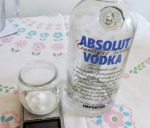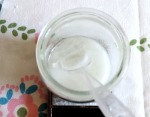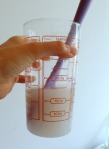Hello there!
I am back, finally, with a brand new recipe of a No-Dandruff Shampoo! 🙂
I wanted to try a new – to me, that is – ingredient: the SCLEROTIUM GUM! 🙂
I lowered the SLES to 23% because I needed a milder shampoo, but if you suffer of dandruff I think you should rise the SLES to 30% as we normally use it 🙂
That said, here a little explanation about the ingredients of this shampoo.
The ingredients which make this shampoo a “no-dandruff” one are two: Piroctone Olamine and Salicylic Acid.
1) Piroctone Olamine – it is a local antiseptic which works against a wide spectrum of bacteria and fungus. It is commonly used in shampoos against dandruff and in Europe it is allowed in “rinse off” cosmetics at the maximum concentration of 1%.
It doesn’t melt easily in water nor in oil but it melts well in alcohol or in water + surfactants solutions.
In this shampoo it is used at 0.5% because it is not the only active ingredient, in fact, it is used together with:
2) Salicylic Acid – NOW STOP YOURSELF!!! Salicylic Acid is NOT fresh water, since it is, in fact, an acid. Be aware that to make this recipe you will definitely need goggles and gloves to protect yourself. Plus, cover your skin (for example, by wearing a long sleeve shirt). It IS dangerous if a drop of it goes into your eyes, so: better to look funny with lab goggles, than to be sorry and blind later! 😉
If this was not clear enough, go back to read from “NOW STOP YOURSELF” until it is very very clear and it convinced you to use goggles and gloves.
Well, as I was saying 😀 Salicylic Acid and Piroctone Olamine work well together 🙂 they help to keep the scalp clean, calm and not itchy 🙂
There is also a third ingredient which is added not much for its effectiveness but more for an accessory effect: the cool effect!
I am talking about Menthol 🙂
Needless to say: if you don’t have Menthol, you can still make a very effective No-dandruff shampoo 🙂
Finally to the RECIPE! 😀
Phase A:
Water to 100 – you find what it means HERE
Glycerin 2
Sclerotium Gum 0.5 (this is my new friend! 🙂 I had never tried this ingredient before. I had to warm the water before, pour it on top of the water and mix it with the immersion mixer separately)
Phase B:
SLES (Sodium Laureth Sulfate) 23
Sodium Cocamphodiacetate 5
Coco Glucoside & Gliceryl Oleate 1
Polyquaternium 7 – 1
Preservative (concentration needed for the specific preservative you are using)
Phase C:
Menthol 0.4
Piroctone Olamine 0.5
Salicylic Acid 0.5
Vodka 3 (or Edible 100% alcohol 1 – I didn’t have Alcohol at the time so I had to use what I had at hand: Vodka! However, since the alcohol in vodka is only around 40% it is clearly less efficient as a solvent and I have made this recipe again a couple of times always using alcohol and of course it was much easier, so I suggest you use alcohol!)
Cocamidopropyl Betaine 8
Now HOW TO proceed:
1) Wear goggles and gloves to protect yourself 🙂 (needless to say: if you have small children or animals around the house… be sure to be alone and not interrupted).
2) I’m not kidding: WEAR GOGGLES AND GLOVES!
3) Measure the Phase C in a third little becher (I use a glass 🙂 ). The alcohol will melt the other three ingredients. Set aside (It takes a while to melt, at least 15 minutes, and you need to stir every now and then, that’s why we do this first).

Here is the very beginning: the dry ingredients and a little amount of vodka to start mixing 🙂

Here I had added Menthol as well (you can see it on the tip of the spoon)
4) Measure the water and the Glycerin (Phase A). Warm up and pour the Sclerotium Gum on top of the water. Mix with a stick blender until smooth. Set aside.

As you can see it was not very transparent as soon as you mix it, but it will be later, in a few days time! 🙂
Sclerotium gum made a very beautiful transparent gel, later on 🙂
I have to say, though, that it tends to not let go bubbles in case you incorporate air when you create the gel: so pay attention to that 🙂 if you want a clear and bubble-less gel/detergent… avoid incorporating air 🙂
5) Measure the Phase B in a second becher, warm up just a little and mix with a spatula.
6) Pour the Phase A into the Phase B little at a time. Mix with a spatula in the beginning, then mix with a stick blender (it will become more smooth and homogeneous).

5) Wear again goggles and gloves now that you are going to touch Phase C: Add the Phase C and mix
6) At the very last moment add the Cocamidopropyl Betaine.
7) Check the pH: it shouldn’t be lower than 5.5 🙂
And TADAAAA 😀
Here I had added also a drop of food red colorant and few drops of my favorite fragrance oil 🙂

I have liked this shampoo a lot! 🙂
So far I have used it for approximately 2 months and it feels great (too bad it is almost finished >< ), the menthol feels just a little cooling, and it is great! 🙂 Maybe not a shampoo for freezing winter mornings, but a must for hot days! 😀
For more recipes click HERE
To learn how to formulate cosmetics click HERE
For a list of online cosmetic ingredients suppliers click HERE
Any questions? 🙂


Thanks for this……I love your posts
LikeLike
I will try to make this shampoo, but find materials are too hard for me 😦
LikeLike
Hello Suny 🙂
Where do you live?
There are really MANY websites that sell around the world 🙂
I also made a post with a list of online shops around the world 🙂
LikeLike
hi! thanks for sharing this recipe. 🙂 does the alcohol serve as a preservative or did you use it for another purpose?
LikeLike
No no here the preservative is another one 🙂
The alcohol here is used in order to “melt” salicylic acid, piroctone olamine and menthol! 🙂
These are ingredients that are difficult to melt in other ways, so alcohol helps 🙂
I have just remade a batch of this recipe 🙂
LikeLike
What is the percentage of salicylic acid in this shampoo?
LikeLike
Hi Tanya. The recipe is in percentages, so 0.5% 🙂
LikeLike
I would like to add colloidal sulfur to the shampoo. To what phase should I add it?
LikeLike
You could add some in the end Tanya.
LikeLike
Hi I need your answer, I have formulated my shampoo with SLES,SLS,CAPB,EDTA,CMEA SODIUM CITEATE, and ph balanced with citric PRESERVATIVE,FRAGRANCE, CENTRIMONIM CHLORIDE, and the pH is 7, after usage of one month,Hair fall and dandroof in my head What is missing in my recipe.
LikeLike
It might be that it is not your shampoo causing the fall or the dandruff (I am not a doctor)… but talking about the recipe: you haven’t written your concentration so I will tell you what I can from the info you have given me.
Are Cetrimonium Chloride and those anionic surfactants compatible? I have never used it mixed with anionic surfactants before and I don’t know how it would behave. I know Cetrimonium Chloride can be aggressive on its own so check the concentration (and the compatibility!).
What is the surfactant concentration of your formula? Could it be too high and therefore dry for your scalp?
Why would you leave a pH 7?
LikeLike
Thanks for your reply following are my formulation.
1,SLES – 11 % PRIMERY SURFACTANT
2,SLS – 4.9 % SECONDARY SURF
3,CAPB – 8 % THIRD SURF
4,PROP.GLYCOL – 2% HUMACTANT
5,GLYCERIN -1% MOISTURISATION
6,SODIUM CITRATE – 2% CHELATENT
7,EDTA (DI) – .5% SEQUESTING AGENT
8,iSO PROPYL MYRISTATE – .5% AVOID GREASYNESS
9,CENTRI CHLORIDE -2% – CONDITIONING
10,DOW CONDITINER – .5 %
11, COCOMONO E.A. -1% FOAM STABILIZATION
12, FRAGRANCE-0.70%
After a long time i got this formulation to get thick gelly like shampoo. I saw an article that shampoo should not Deavoid all sebum. if removed completely dry scalp is the result so flakes and itching etc happening. Is their any best ingredient to suggest me like cetyl,caster oil etc to maintain sebum level. and which is the best pH value to maintain hair. Again thanks for your reply.
LikeLike
I haven’t used some of these ingredients myself but this is what I thought:
Propylene glycol looks unnecessary here. It is in a sense a humectant but it works in a way that I personally not like and it might ruin the binding of the skin cells making it easier for aggressive surfactants to come through and do a little damage.
I don’t think of huge damage here, but a little dandruff maybe yes.
Your surfactants were all liquid, right? Or did you use powders?
I would avoid even isopropyl myristate if this is a shampoo for yourself and not for commercialization.
Cetrimonium chloride again is what makes me thoughtful. I don’t see its use in a shampoo. Yes it is a conditioning agent but are you sure it is compatible here? Why don’t you add other compatible conditioning substances like quat 80, polyquat 7 or 10 for example? 🙂
LikeLike
For makin the shampoo milder you could add a very small amount of oil like 1% BUT my personal rule is that if I want a milder detergent I make it milder by using different surfactants or simply lowering them rather than using up their washing abilities to solubilize my 1% oil. This is just my preference
LikeLike
Yes thanks for you support. Another one question, Is their any simple method to find out the product is Moisturising,conditioning and safe to skin.
LikeLike
Well I don’t know if it is simple enough, but studying is one way 🙂 there are many books that talk about cosmetic science or chemistry 🙂
LikeLike
Is the salicylic acid in this shampoo dangerous if it gets in your eyes while shampooing? You made such a serious point to wear gloves and googled when handling it so I’m concerned about safety in shampooing
LikeLike
The danger, as with anything, is in the quantity. Handling an acid in pure form without gloves is dangerous, handling something that has a small percentage of an acid is not that dangerous.
Surely it is not a good thing if it gets in the eyes, but nevertheless also all the other ingredients of all shampoos in the world are not a good thing to get in the eyes! 🙂 So, if it happens, just be sure to rinse very well and if stinging lasts too long visit a doctor, but this is true for any substance really 🙂
LikeLike
hi, for Phase B can I omit Sodium Cocamphodiacetate ,Coco Glucoside & Gliceryl Oleate ,Polyquaternium. Just adding Cocamidopropyl Betaine to milder the SLES?
LikeLike
You can, but it won’t be as mild as with all the ingredients. 🙂
LikeLike
Thanks for your reply. If i only have sles 70% and coco betaine. What is the % should i use for these 2? Do i need to dilute sles first?
LikeLike
I wrote a post about formulating with surfactants where all the calculations are explained 🙂 you will need to remake the calculations. No need to dilute SLES separately 🙂
LikeLike
Thanks a lot dear. Loves your sharing and may god bless you 🙂
LikeLiked by 1 person
Hi. Just made mine today with whatever ingredients i have on hand.
A
Water to 100
Glycerin 2
Xanthan gun 0.2
B
SLES 22
polyquat7 1
C
Menthol 0.4
Salycilic acid 0.5
Alcohol just a little to dilute SA
Cocamidopropyl Betaine 10
Germall plus
Spearmint and lemon e.o
LikeLiked by 1 person
How are you doing today?
I have sodium cocoyl isethionate and cocobetaine, can i use both alone? If yes, please what percentage will u advice? I checked your formulatory but i didnt see any information on sodium cocyl isethionate.
LikeLike
Is it in powder form the isethionate
LikeLike